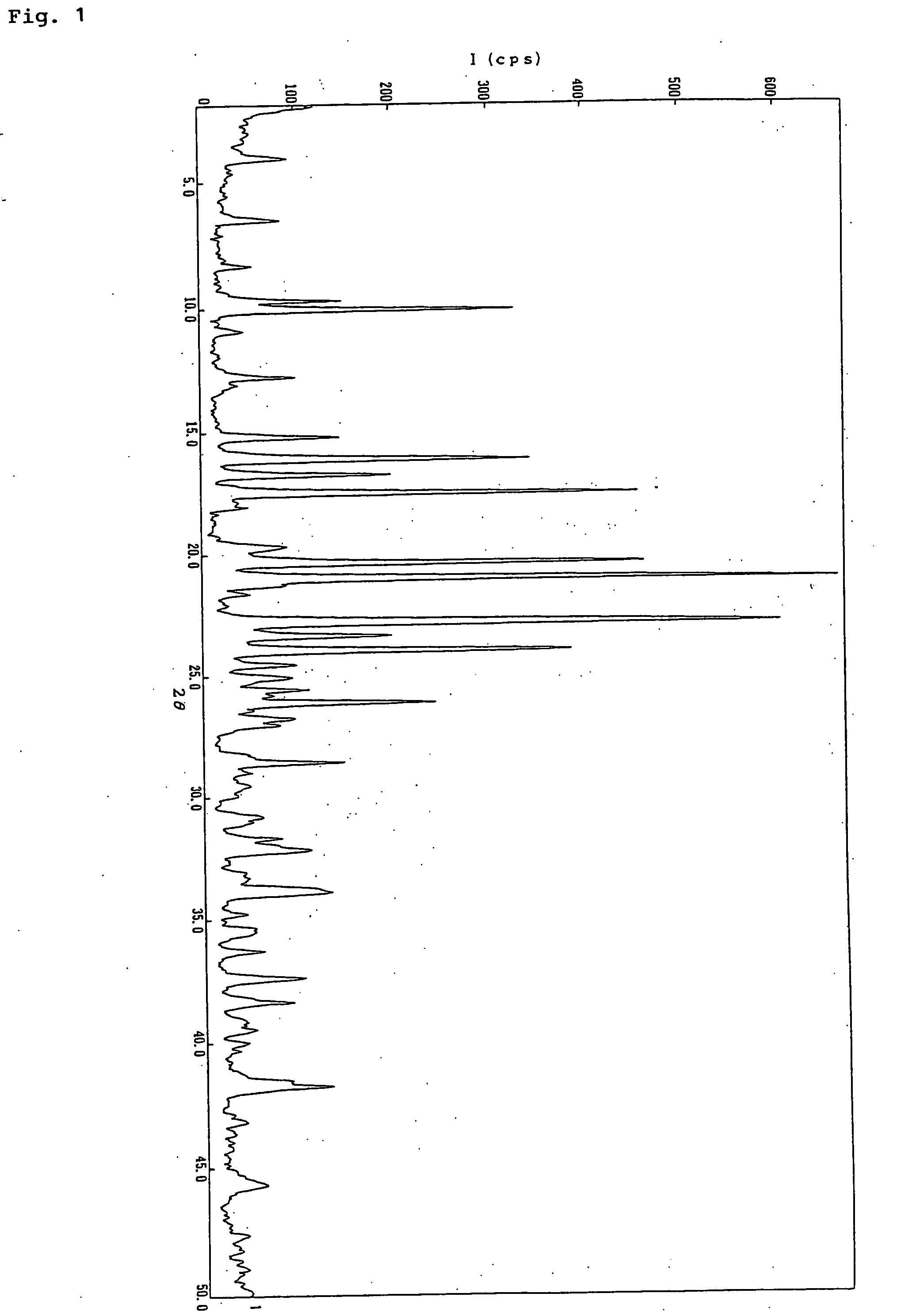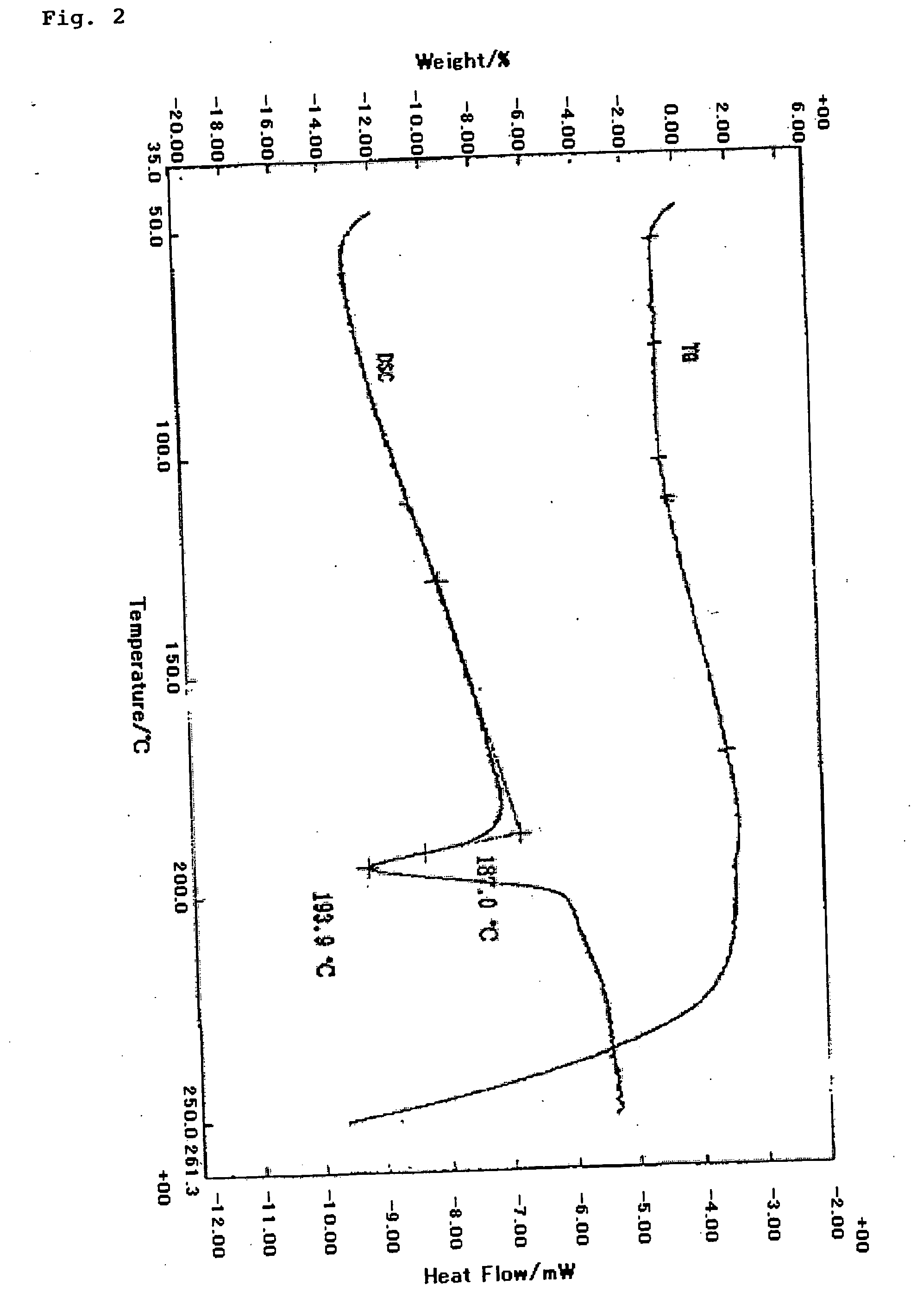Process for producing acid adduct salt of polyacidic base compound
a polyacidic base compound and acid addition technology, applied in the field of polyacidic base compound acid addition salts, can solve the problems of aluminum sheets, aluminum tablets may undergo metal corrosion, and the oral absorption of little well, and achieve the effect of weakening the acidity of the acid
- Summary
- Abstract
- Description
- Claims
- Application Information
AI Technical Summary
Benefits of technology
Problems solved by technology
Method used
Image
Examples
example 1
Preparation of 2-[4-[2-(benzimidazol-2-ylthio)ethyl]piperazin-1-yl]-N-[2,4-bis(methylthio)-6-methyl-3-pyridyl]acetamide monohydrochloride 0.9-water adduct
[0052] (1) After heating and dissolving the free base (2.00 kg, 3.98 mol) of 2-[4-[2-(benzimidazol-2-ylthio)ethyl]piperazin-1-yl]-N-[2,4-bis(methylthio)-6-methyl-3-pyridyl]acetamide and pyridine hydrochloride (0.92 kg, 7.96 mol) in ethanol. (12 L) at reflux temperature, water (20 L) was added dropwise to the reaction mixture at 75 to 87° C. The reaction mixture was allowed to cool down to room temperature, and was stirred for 1 hour. Precipitated crystals were collected by filtration. The crystals were washed with water and dried at 80° C. under reduced pressure to obtain 2-[4-[2-(benzimidazol-2-ylthio)ethyl]piperazin-1-yl]-N-[2,4-bis(methylthio)-6-methyl-3-pyridyl]acetamide monohydrochloride water adduct (1.96 kg, 89.0%; found to contain 2% of ethanol from 1H-NMR) as colorless needles.
[0053] (2) 2-[4-[2-(Benzimidazol-2-ylthio)et...
referential example 1
Preparation of 2-[4-[2-(benzimidazol-2-ylthio)ethyl]piperazin-1-yl]-N-[2,4-bis(methylthio)-6-methyl-3-pyridyl]acetamide tetrahydrochloride 2-water adduct
[0060] The free base (134.31 g, 0.267 mol) of 2-[4-[2-(benzimidazol-2-ylthio)ethyl]piperazin-1-yl]-N-[2,4-bis(methylthio)-6-methyl-3-pyridyl]acetamide was dissolved in methanol (500 mL), followed by the dropwise addition of 10% (w / v) hydrogen chloride in methanol (607.6 g, 1.666 mol) over 15 minutes under stirring at 0° C. Diethyl ether (700 mL) was added, and the mixture was left over for 2 hours. Precipitated crystals were collected by filtration, washed successively with a 1:1 mixed solvent (500 mL) of methanol-diethyl ether and diethyl ether (500 mL), and dried at room temperature for 3 hours under reduced pressure to afford the title compound (133.54 g, 73.0%) as colorless crystals.
[0061] Melting point: 193-196° C.
[0062] IR(KBr)cm−1: 3405, 2922, 1699, 1614, 1564, 1516.
[0063]1H-NMR (400 MHz, DMSO-d6) δ: 2.42 (3H, s), 2.43 (3...
referential example 2
Preparation of 2-[4-[2-(benzimidazol-2-ylthio)ethyl]piperazin-1-yl]-N-[2,4-bis(methylthio)-6-methyl-3-pyridyl]acetamide disulfate 1.5-water adduct
[0067] Sulfuric acid (purity: 96%, 799.9 mg, 7.83 mmol) was diluted with water (1.5 mL). The free base (1.94 g, 3.86 mmol) of 2-[4-[2-(benzimidazol-2-ylthio)ethyl]piperazin-1-yl]-N-[2,4-bis(methylthio)-6-methyl-3-pyridyl]acetamide was added to the above diluted sulfuric acid, and dissolved at room temperature. Ethanol (4.5 mL) was added, and a viscous substance formed was dissolved under heat. The solution was stirred at room temperature for 10 minutes, followed by the further addition of ethanol (9 mL). The mixture was chilled under stirring in ice water. Precipitated crystals were collected by filtration, and heated and dried at 80° C. for 3 hours under reduced pressure to afford the title compound (2.64 g, 94.3%) as a colorless powder.
[0068] Melting point: 204-208° C.
[0069] IR(KBr)cm−1: 3403, 1700, 1617, 1567, 1521.
[0070]1H-NMR(400 ...
PUM
| Property | Measurement | Unit |
|---|---|---|
| temperature | aaaaa | aaaaa |
| temperature | aaaaa | aaaaa |
| temperature | aaaaa | aaaaa |
Abstract
Description
Claims
Application Information
 Login to View More
Login to View More - R&D
- Intellectual Property
- Life Sciences
- Materials
- Tech Scout
- Unparalleled Data Quality
- Higher Quality Content
- 60% Fewer Hallucinations
Browse by: Latest US Patents, China's latest patents, Technical Efficacy Thesaurus, Application Domain, Technology Topic, Popular Technical Reports.
© 2025 PatSnap. All rights reserved.Legal|Privacy policy|Modern Slavery Act Transparency Statement|Sitemap|About US| Contact US: help@patsnap.com



